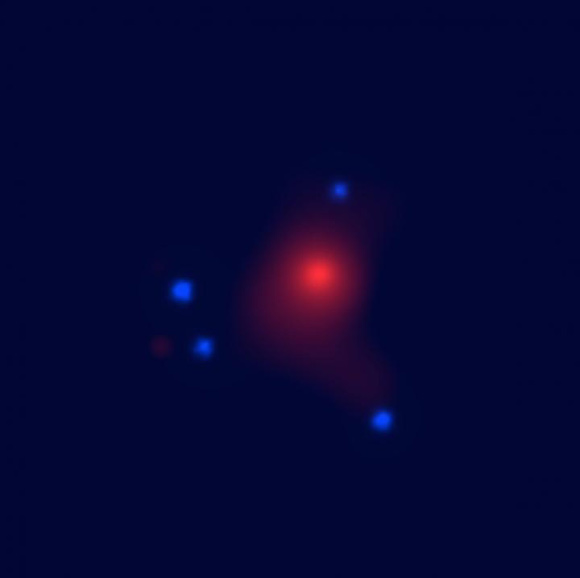Free-Floating Planet-Mass Objects are Common in Galaxies | Astronomy – Sci-News.com
Using a technique called quasar microlensing, a team of astronomers at the University of Oklahoma has detected populations of free-floating planet-mass objects — exoplanets and/or primordial black holes — in two extragalactic systems: a lensing galaxy called Q J0158-4325 and the lensing galaxy cluster SDSS J1004+4112. These are only the second and third such detections in galaxies beyond our own.

X-ray image of the gravitational lens system SDSS J1004+4112 taken by NASA’s Chandra X-ray Observatory; the central red extended emission is from the hot gas in the foreground lens galaxy cluster and the four blue point sources are the lensed images of the background quasar. Image credit: University of Oklahoma.
Q J0158-4325 is a galaxy-quasar lensing system, where a background quasar at a distance of 8.8 billion light-years is gravitationally lensed by a foreground galaxy at a distance of 3.6 billion light-years.
The lensing system SDSS J1004+4112 consists of a massive galaxy cluster at a distance of 6.3 billion light-years and a source quasar at a distance of 9.9 billion light-years.
Dr. Xinyu Dai from the Homer L. Dodge Department of Physics and Astronomy at the University of Oklahoma and colleagues analyzed decade-long observations of these systems from NASA’s Chandra X-ray Observatory.
The evidence for planet-mass objects — with masses ranging from Moon to Jupiter mass — in the foreground galaxies was derived from the microlensing signals that appear as shifts in the X-ray emission line of the background quasars.
“These unbound objects are either free-floating planets or primordial black holes,” the researchers said.
“Free-floating planets were ejected or scattered during stellar/planetary formation. Primordial black holes are formed in the early phase of the Universe due to quantum fluctuation.”
“We are very excited about the detections in two news systems,” said Saloni Bhatiani, a Ph.D. student at the University of Oklahoma.
“We can consistently extract signals from planet mass objects in distant galaxies. This opens a new window in astrophysics.”
The team also found that planet-mass objects in Q J0158-4325 and SDSS J1004+4112 systems account for about 0.03% and 0.01% of the total mass of the system, respectively.
“The detection of planet-mass objects, either free-floating planets or primordial black holes, are extremely valuable for modeling of star/planet formation or the early Universe,” Dr. Dai said.
“Even without decomposing the two populations, our limit on the primordial black hole population are already a few orders of magnitude below previous limits in this mass range.”
“The results are of significant importance as they confirm that planet-mass objects are indeed universal in galaxies,” the scientists concluded.
Their work was published in the Astrophysical Journal.
_____
Saloni Bhatiani et al. 2019. Confirmation of Planet-mass Objects in Extragalactic Systems. ApJ 885, 77; doi: 10.3847/1538-4357/ab46ac






